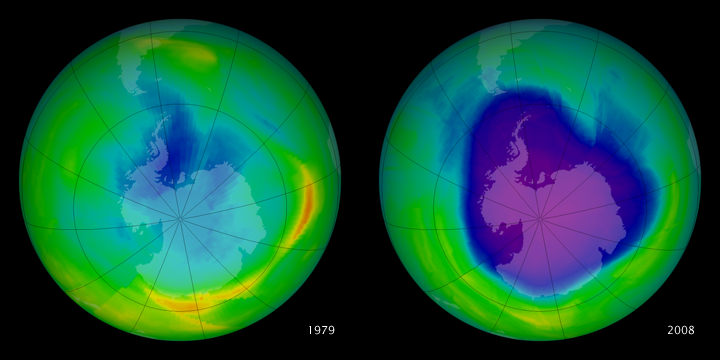

The hole in the ozone layer, which shocked humanity when it was first discovered 40 years ago, is now on track to heal completely—and soon. According to a new United Nations report, the vast majority of the earth’s ozone layer should be healed by 2040. That excludes areas over the poles, which are recovering at a slightly slower rate. The ozone layer over those regions will be healed completely by 2066 if current trends continue.
Videos by Outdoors
The ozone layer is an atmospheric shield that protects the earth from harmful UV rays. The hole in this shield was discovered in 1985 by scientists with the British Antarctic Survey (BAS), a group that conducts cutting-edge polar research and satellite monitoring projects. The researchers also uncovered the reason for the damage: a group of ozone-degrading, synthetic chemicals that humans had released into the atmosphere. Among the most well-known were chlorofluorocarbons (CFCs), which were then used to manufacture aerosol sprays and as refrigerants.
In a landmark decision, global leaders came together in Montreal in 1989 and pretty much unanimously agreed to ban CFCs and other ozone-degrading chemicals. Since then, the atmosphere has been slowly repairing itself, a result that has protected natural landscapes, human beings, and valuable food crops alike from life-threatening UV damage.
According to the report, the global CFC ban had another major benefit. CFCs are potent greenhouse gasses, so if we had continued dumping them into the air for the last 40 years, the planet would have warmed by an estimated 1°C more than it already has.
The success of the Montreal Protocol offers a valuable case study for what can happen when world leaders come together for the benefit of the planet.
“Ozone action sets a precedent for climate action,” said meteorology expert Professor Petteri Taalas in a press release put out by the World Meteorological Society. “Our success in phasing out ozone-eating chemicals shows us what can and must be done—as a matter of urgency—to transition away from fossil fuels, reduce greenhouse gasses, and limit temperature increase.”

In the ozone report, the United Nations also examined the potential impacts of a unique but controversial climate solution: injecting reflective particles into the atmosphere in an attempt to further shield the earth from solar rays. In theory, this could prevent future global warming. However, the report speculates that messing with the atmosphere at that scale could have detrimental effects to the ozone, not to mention other unintended consequences.
For now, the biggest takeaway from the report isn’t about adopting a novel technological solution to climate change. Instead, it’s about coming together and doing what we can to help our planet heal on its own.









